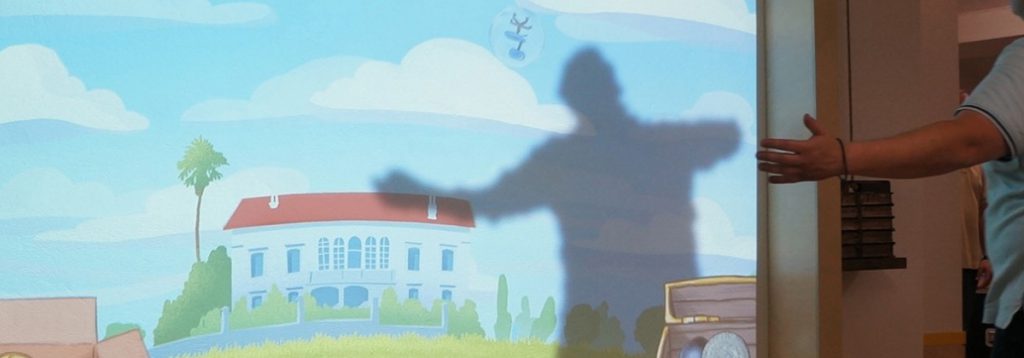Eleftherios Venizelos lived in his paternal house, in Chalepa (Chania), for more than thirty years, from 1880 to 1910, and occasionally, from 1927 to 1935. The historical residence has been restored and concerted into a commemorative site and a modern museum. Since its restoration, the exhibition features innovative technologies.
Seven (7) interactive systems have been installed in the Venizelos Residence Museum, in collaboration with FORTH-ICS Ambient Intelligence. Four (4) of them are in the education hall and the rest two (2) are part of the main exhibition.
- Interactive Wall supports games that can played by one, two or more players simultaneously, using their entire body, in a space of about 3 x 3 m comprising a large projection area. Players control the game using their “virtual” shadows which are projected on the screen and follow their body movements. Players have to use their shadows to seperate belongings of Eleftherios Venizelos from modern items and address them to the corresponding basket. During the game, the players get photographed by the system. In some installations an additional touch screen is also used as a means of seeing and immediately sending the photos to an e-mail address.
- Infocloud comprises a collection of keywords, images and video thumbnails displayed on a large touch screen. When a word/image is selected, an information window opens, which may contain an image or video accompanied by a short textual description related to Venizelos life. All selected items can be freely moved and tossed around, as well as magnified or shrunk using multi touch gestures.
- Jigsaw Puzzle offers a typical puzzle game functionality including a multitouch screen. The user is called to select a picture from an image gallery and the difficulty level in order afterall to fulfil the puzzle’s completion.
- PaperView is a tabletop augmented reality system that supports the exploration of terrain-based information (e.g., areas of interest on a 2D map, or a 3D scale model) using rectangular pieces of plain cardboard. The system allows users to study information and interactive multimedia, using the cardboards as individual interactive screens; these cardboard screens can be lifted and held at various angles. Multiple users can concurrently use the table.
- Cryptolexo the hidden crossword puzzle, combines entertainment with knowledge. Within the matrix of letters, significant words are hidden. Once a word is discovered, multimedia information about it is displayed. The system uses a touch screen. Users can find the hidden words on the touch screen by dragging their finger from the start to the end of each word or, alternatively, by touching each word’s first and last letter. Further related information appears on the screen.
- TimeViewer is an interactive system that presents information with temporal characteristics in a large scale display, while user interaction is achieved through remote gesturing. Besides representing information as a traditional two-dimensional timeline, the system also supports three-dimensional information representation in a “time-tunnel”, i.e., a corridor along which the events are placed in chronological order. User interaction in the time-tunnel is accomplished through full-body kinesthetic interaction.
- Infoscope is a novel mobile device that can support knowledge discovery and exploratory playing in physical environments. Infoscope utilizes RFID technology to provide audio guiding and localized question / answer games, while it employs wireless communication technologies to exchange information about its user’s interests with computer platforms and to present through them related supplementary multimedia information. The device comes with two accompanying software components: one for editing / updating its contents, and one running on personal computers for providing supplementary multimedia information.
